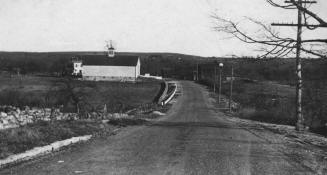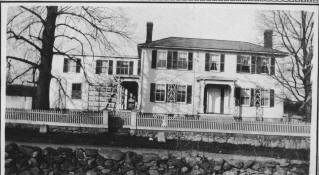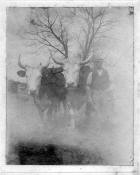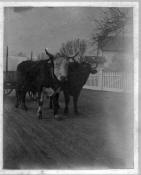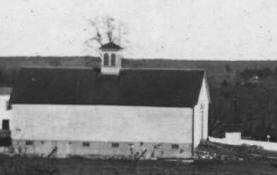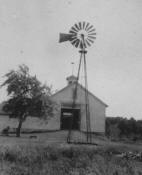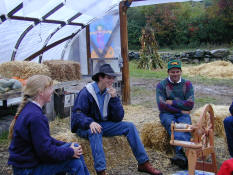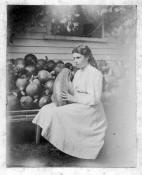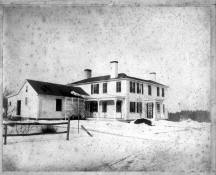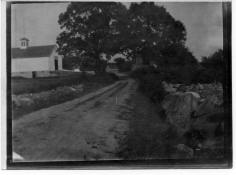Our History
The Cook family has been
living and farming in the Blackstone Valley area since 1664. Walter Cooke
along with a few other families settled the town of Mendon. Obtaining a
grant of land in 1705 Walter’s son, Nicolas, settled in the south
Bellingham area. This grant, which contains the present day farm, was for
“land east of the Great River and both sides of the Peter’s River.”
Nicolas’ son Josiah was the
first generation known to actually raise crops and live on the farm we know
today. We know that Josiah was busy planting apple trees because his will,
written in 1757, mentions the orchards in West Wrentham. Josiah was a
religious man and church played an important part in his life. In 1732
Josiah Cooke’s family, along with the Ballous, the Jillsons, the Whipples,
and other families living in the Attlebough Gore area, organized a Baptist
church. This area is now part of North Cumberland. Later in the 1740's
Josiah built their meeting house on land donated by James Ballou. It was
originally known as the Elder Cooke Meeting House named after Elder Josiah
Cooke, their first deacon. The name was later changed to the Elder Ballou
Meeting House in honor of Elder Abner Ballou, who was Pastor from 1775-1806.
Through the 1800's, like
many New England farms, a wide variety of products were being raised. Land
was cleared, crops planted, and buildings erected. They continued to raise
the mainstay of fruits and vegetables along with beef, pork, milk, and
eggs. The products were mostly sold in the then growing mill town of
Woonsocket, RI. On Tuesdays and Thursdays the horse drawn wagon (now set up
in the loft of the barn) was loaded up, and brought to the Falls Market
Square. There they sold produce off the wagon much like the farmers’
markets of today.
In the 1800s, like several
farms in the Blackstone area, the Cooks had a cobbler’s shop where they made
and repaired shoes. The building remained on the farm until the 1970s.
The original cape style
farmhouse, located across from the barn was torn down. In 1828 the present
day house was built to accommodate a family of 13 children. Later on,
additions were added and a second story constructed over the woodhouse
section of the original house.
The barn that now contains
the farm store, was built somewhere between the late 1700s and early 1800s.
The last three sections of the barn are the original building made of hand
hewed post and beam construction. Around 1880 the front ten foot section
was added on to accommodate horses. The beams in this section show the
circular marks of a saw mill. The whole structure was jacked up and a cellar
was dug out. The manures from the animals were dropped down into the cellar
and stored there until it could be spread on the fields. This popular
manure handling method of the time kept the nutrients from being leached out
of the “fertilizer” needed for good soil fertility. Later in the 1950's it
was again dug out and cemented to accommodate the dairy herd.
The small building in the
parking lot was used as a cistern well to water the animals in the barn.
Water was collected off the roof of the barn and directed to the cistern
through a pipe. Water was then taken out by buckets and dumped into a
trough that was inserted through the U shaped hole on the barn yard side of
the building.
Each
generation added their own modernization to the farm. Horace Cook, farming in
the mid 1800s was of the last generation to use oxen extensively for field
work. His son, E.R. (Ererard Rufus), would bring the farm into the modern age
of horse power. His father, having farmed with oxen all his life, was
displeased and felt horses were too fast and dangerous. Many years later E.R.s
grandsons had a difficult time convincing him to jump into the modern age of
tractors for much the same reasons. E.R., at the 1876 Centennial World’s Fair
in Philadelphia, PA, bought a windmill. He announced to the family he was never
again going to lug water from the well. His father, who initially didn’t
believe it would work, later claimed it was his idea. There was a 1000 gallon
tank placed in the loft of the barn to store the water. There water was gravity
fed to supply the house and barn. The windmill many years later was blown
apart in the hurricane of 1938.
Things continued to change
through the 1900s on the farm, although fruit remained an important crop. West
Wrentham and Sheldonville, at one time, had a lot of apple farms. Poultry and
dairy were also becoming important products in the area. Cities like Woonsocket
continued to grow and demand for agricultural products grew along with the
population. During WWII prices for poultry and eggs were high because they were
not rationed like other meats. Like the generations before, products were
brought into Woonsocket to sell. However by this time a home delivery system
was more popular.
After the Korean War Howard
Cook established a modern dairy operation. With the need for milk
pasteurization, raw milk was sold in bulk to a dairy who would pasteurize and
bottle the milk. The farm at that time sold milk to Carl Whipple Dairy, located
at the top of Cook’s Hill. Carl would then process it and sell bottled milk
delivered to the customer’s door. Howard’s brother, Ernest was raising apples,
vegetables and poultry. As the 1960's approached it became too expensive to
ship grain from the mid-west. It became cheaper to ship milk and eggs into the
area. At that time most of the dairy and poultry farms in the area either went
completely out of business or had to change.
With the words of grandpa E.R.
still strong in the memories of the Cook brothers the farm went back to
primarily fruit and vegetables. E.R. would tell his children and grandchildren
that “ people don’t want to cook any more. They just want something they can
eat out of their hands.” In 1977 Howard’s son Warren took over the farming
operation, planting more fruit trees and expanding the vegetable production. The
farm continues today primarily as a fruit and vegetable production farm–selling
retail to the public through the farm stand and farmers’ markets. Although a
great deal has changed on the farm through the years, much has stayed the same.
Nate Cook the tenth generation to work this land is now beginning to put his
ideas to work-planting blueberries, erecting cold frames to extend the growing
season, and looking forward to working the same land as his forefathers.
